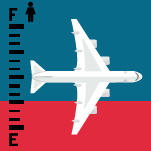Why low oil prices did not transfer into low airplane-ticket-fares
Posted By Ceci On 28 January, 2016 @ 2:05 pm In Edition 55,Strategy,Marketing | No Comments
 Por: Paolo Morganti
Por: Paolo Morganti
Since June 2014, the world has assisted to a dramatic fall in the price of oil, which reached approximately half of its previous value.
While this turn of events has hurt producers of oil, like Mexico, it has – or should have – benefitted consumers and companies that use oil as a main input of production. Like airline companies.
It would be natural to expect airline companies to transfer parts of these benefits to consumers in the form of lower travel fares. But those of you who tried to travel in the past year have probably noticed that airplane tickets have not gotten any lower: over some U.S. routes the average fare has even increased by 10USD. What is happening to the industry? Could travelers expect cheaper fares any time soon?
Some representative of the industry has commented that because airline companies are working with long-term oil contracts they are still paying old prices. But these arguments have been dismissed after other exponents admitted that the industry was enjoying a period of unprecedented savings (jet fuel is an airline company’s major expense).
In a competitive environment companies who set prices should fight with discounts until they fill all their seats, cutting their ticket prices down to their marginal costs. And the airline industry has shown in different occasions to be very competitive, bringing notoriously low returns to its shareholders. How is it possible that such a competitive industry has failed to transfer its cost savings to the customers?
One might argue that at end ticket fares depend on travelers’ willingness to pay, and data show that not only are travelers willing to pay these high prices, but airplanes are also flying at almost full capacity! This seems to suggest that actual fares are somehow “fair”.
They key of the puzzle lies in that “capacity”. For an airplane, capacity is given by the number of seats that the company makes available in each category. When companies set a large capacity, customers can find seats more easily or they can delay their purchases with less fear of potentially losing an offer. Also, from the company’s perspective, large capacity would likely bring more empty seats that could only be filled with aggressive discounts. Following these examples, we can begin to understand how large capacity usually leads to lower prices. Analogously, high prices can be usually connected to small capacity. Therefore, when industry representatives state that airplanes are already flying at full capacity they are only presenting one side of the problem. Airplanes are flying at full capacity because the companies have reduced the number of seats available per airplane.
For instance, in a recent trip to Europe I noticed that Lufthansa has introduced a new seat-category called Economy Plus on its flights. While being located in the Economy part of the airplane, this category offers more space in exchange for a higher fare. Apart from allowing for better market segmentation – and therefore higher revenues through price discrimination- the introduction of this category has allowed the company to further reduce the total number of seats available on an airplane, stealing space to the Economy class. Next time you praise an airline company for the good space between seats, remember that you are paying a hidden fee for this space!
Concerns for consumers’ welfare have recently moved the American Antitrust authority to put the industry under investigation. The accusation is that airline companies have tacitly colluded in keeping capacity low.
What are the factors that have contributed to the relaxation of competitive pressure in the last few years? First, the emergence of code sharing alliances has reduced the number of independent players, promoting instead large and coordinated groups. Second, in the U.S. there have been some major mergers (see for instance U.S. Airways and American Airlines) that consolidated the industry, making tacit coordination among rivals easier.
Should we expect to see lower ticket prices anytime soon? Travelers should not be too hopeful. The Antitrust investigation is bound to take some time, and it may be difficult to prove airline companies guilty. Moreover, even if airline companies wanted to add capacity to their flights, they would not be able to do so in the short run. In addition, by the time they could accomplish that, the global oil prices might have returned to historical highs.
This lesson showed the role of capacity in preserving profitability in aggressive markets: capacity moves strategy away from quick and reciprocally dangerous price reactions, into a realm of slow quantity adjustments that stop the erosion of profits.
For a company, moving from a price-setting to a capacity-setting strategy is a way to avoid the harms of price wars and creating a friendlier competitive environment. As a strategic variable, capacity is more rigid to adjust than price is, and therefore is not the optimal tool to react fast and aggressively to a rival’s move. When all companies in the industry adopt this strategy, aggressive play slows down and competitive pressure in the industry will become low. Returns skyrocket and prices stay high.
Article printed from Dirección Estratégica: http://direccionestrategica.itam.mx
URL to article: http://direccionestrategica.itam.mx/why-low-oil-prices-didnt/